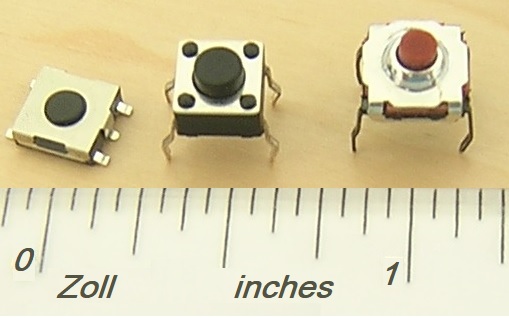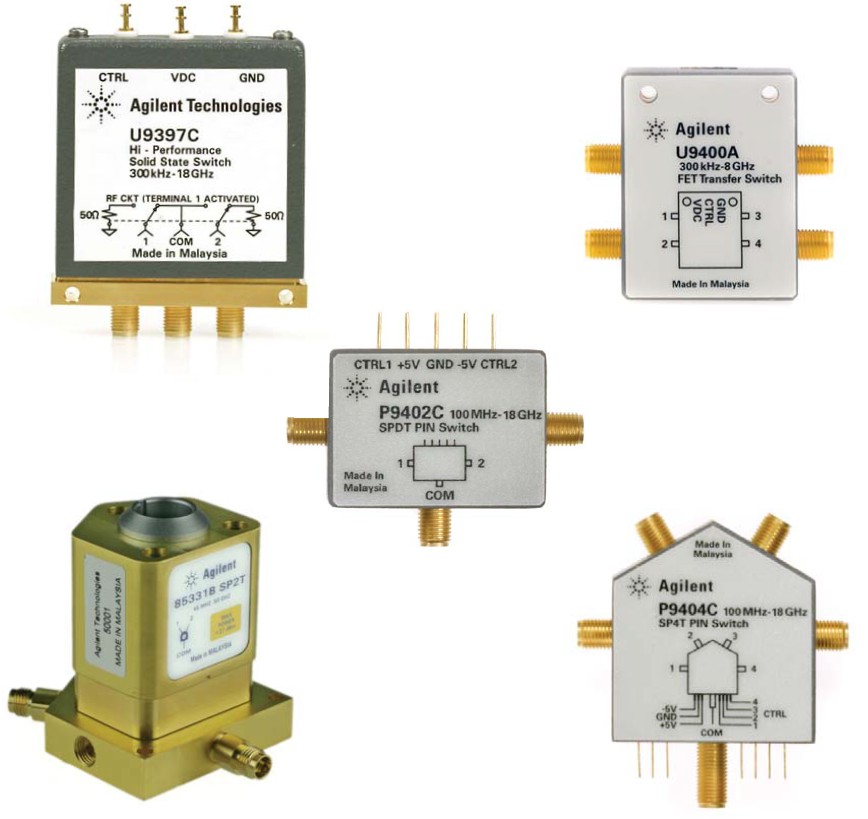|
Transmission Gate
A transmission gate (TG) is an analog gate similar to a relay that can conduct in both directions or block by a control signal with almost any voltage potential. It is a CMOS-based switch, in which PMOS passes a strong 1 but poor 0, and NMOS passes strong 0 but poor 1. Both PMOS and NMOS work simultaneously. Structure In principle, a transmission gate is made up of two field-effect transistors (FET), in which – in contrast to traditional discrete field-effect transistors – the substrate terminal (bulk) is not connected internally to the source terminal. The two transistors, an n-channel MOSFET and a p-channel MOSFET, are connected in parallel with the drain and source terminals of the two transistors connected together. Their gate terminals are connected to each other by a NOT gate (inverter), to form the control terminal. Unlike with discrete FETs, the substrate terminal is not connected to the source connection. Instead, the substrate terminals are connected to the resp ... [...More Info...] [...Related Items...] OR: [Wikipedia] [Google] [Baidu] |
Relay
A relay Electromechanical relay schematic showing a control coil, four pairs of normally open and one pair of normally closed contacts An automotive-style miniature relay with the dust cover taken off A relay is an electrically operated switch. It has a set of input terminals for one or more control signals, and a set of operating contact terminals. The switch may have any number of contacts in multiple contact forms, such as make contacts, break contacts, or combinations thereof. Relays are used to control a circuit by an independent low-power signal and to control several circuits by one signal. They were first used in long-distance telegraph circuits as signal repeaters that transmit a refreshed copy of the incoming signal onto another circuit. Relays were used extensively in telephone exchanges and early computers to perform logical operations. The traditional electromechanical relay uses an electromagnet to close or open the contacts, but relays using other operati ... [...More Info...] [...Related Items...] OR: [Wikipedia] [Google] [Baidu] |
Multiplexer
In electronics, a multiplexer (or mux; spelled sometimes as multiplexor), also known as a data selector, is a device that selects between several Analog signal, analog or Digital signal (electronics), digital input signals and forwards the selected input to a single output line. The selection is directed by a separate set of digital inputs known as select lines. A multiplexer of 2^n inputs has n select lines, which are used to select which input line to send to the output. A multiplexer makes it possible for several input signals to share one device or resource, for example, one analog-to-digital converter or one communications transmission medium, instead of having one device per input signal. Multiplexers can also be used to implement Boolean algebra, Boolean functions of multiple variables. Conversely, a demultiplexer (or demux) is a device that takes a single input signal and selectively forwards it to one of several output lines. A multiplexer is often used with a complem ... [...More Info...] [...Related Items...] OR: [Wikipedia] [Google] [Baidu] |
Tri-state Logic
In digital electronics, a tri-state or three-state buffer is a type of digital buffer that has three stable states: a high voltage output state (logical 1), a low output state (logical 0), and a high-impedance (Hi-Z) state. In the Hi-Z state, the output of the buffer is effectively disconnected from the subsequent circuit. Tri-state buffers are commonly used in bus-based systems where multiple devices are connected to the same shared bus, because the Hi-Z state allows other devices to drive the bus without interference from the tri-state buffer. For example, in a computer system, multiple devices such as the CPU, memory, and peripherals may be connected to the same data bus. To ensure that only one device can transmit data on the bus at a time, each device is equipped with a tri-state buffer. When a device wants to transmit data, it activates its tri-state buffer, which connects its output to the bus and allows it to transmit data. When the transmission is complete, the device ... [...More Info...] [...Related Items...] OR: [Wikipedia] [Google] [Baidu] |
Analog-to-digital Converter
In electronics, an analog-to-digital converter (ADC, A/D, or A-to-D) is a system that converts an analog signal, such as a sound picked up by a microphone or light entering a digital camera, into a Digital signal (signal processing), digital signal. An ADC may also provide an isolated measurement such as an electronic device that converts an analog input voltage or Electric current, current to a digital number representing the magnitude of the voltage or current. Typically the digital output is a two's complement binary number that is proportional to the input, but there are other possibilities. There are several ADC hardware architecture, architectures. Due to the complexity and the need for precisely matched electronic component, components, all but the most specialized ADCs are implemented as integrated circuits (ICs). These typically take the form of metal–oxide–semiconductor (MOS) mixed-signal integrated circuit chips that integrate both Analogue electronics, anal ... [...More Info...] [...Related Items...] OR: [Wikipedia] [Google] [Baidu] |
Mixed-signal
A mixed-signal integrated circuit is any integrated circuit that has both analog circuits and digital circuits on a single semiconductor die."ESS Mixed Signal Circuits" Their usage has grown dramatically with the increased use of , , portable electronics, and automobiles with electronics and digital sensors. Overview |
List Of 7400-series Integrated Circuits
The following is a list of 7400-series digital logic integrated circuits. In the mid-1960s, the original 7400-series integrated circuits were introduced by Texas Instruments with the prefix "SN" to create the name SN74xx. Due to the popularity of these parts, other manufacturers released pin-to-pin compatible logic devices and kept the 7400 sequence number as an aid to identification of compatible parts. However, other manufacturers use different prefixes and suffixes on their part numbers. Overview Some TTL logic parts were made with an extended military-specification temperature range. These parts are prefixed with 54 instead of 74 in the part number. A short-lived 64 prefix on Texas Instruments parts indicated an industrial temperature range; this prefix had been dropped from the TI literature by 1973. Most recent 7400-series parts are fabricated in CMOS or BiCMOS technology rather than TTL. Surface-mount parts with a single gate (often in a 5-pin or 6-pin package) are prefixe ... [...More Info...] [...Related Items...] OR: [Wikipedia] [Google] [Baidu] |
List Of 4000-series Integrated Circuits
The following is a list of CMOS 4000-series digital logic integrated circuits. In 1968, the original 4000-series was introduced by RCA. Although more recent parts are considerably faster, the 4000 devices operate over a wide power supply range (3V to 18V recommended range for "B" series) and are well suited to unregulated battery powered applications and interfacing with sensitive analogue electronics, where the slower operation may be an EMC advantage. The earlier datasheets included the internal schematics of the gate architectures and a number of novel designs are able to 'mis-use' this additional information to provide semi-analog functions for timing skew and linear signal amplification. Due to the popularity of these parts, other manufacturers released pin-to-pin compatible logic devices and kept the 4000 sequence number as an aid to identification of compatible parts. However, other manufacturers use different prefixes and suffixes on their part numbers, and not all device ... [...More Info...] [...Related Items...] OR: [Wikipedia] [Google] [Baidu] |
Changeover Switch
In electrical engineering, a switch is an electrical component that can disconnect or connect the conducting path in an electrical circuit, interrupting the electric current or diverting it from one conductor to another. The most common type of switch is an electromechanical device consisting of one or more sets of movable electrical contacts connected to external circuits. When a pair of contacts is touching current can pass between them, while when the contacts are separated no current can flow. Switches are made in many different configurations; they may have multiple sets of contacts controlled by the same knob or actuator, and the contacts may operate simultaneously, sequentially, or alternately. A switch may be operated manually, for example, a light switch or a keyboard button, or may function as a sensing element to sense the position of a machine part, liquid level, pressure, or temperature, such as a thermostat. Many specialized forms exist, such as the toggle switch ... [...More Info...] [...Related Items...] OR: [Wikipedia] [Google] [Baidu] |
Electronic Switch
In electronics, an electronic switch is a switch controlled by an Passivity (engineering), active electronic component or device. Without using moving parts, they are called solid state switches, which distinguishes them from mechanical switches. Electronic switches are considered Binary number, binary devices because they dramatically change the Electrical resistivity and conductivity, conductivity of a path in electrical circuit between two extremes when switching between their two states of ''on'' and ''off''. History Many people use metonymy to call a variety of devices that conceptually connect or disconnect signals and communication paths between electrical devices as "switches", analogous to the way mechanical switches connect and disconnect paths for electrons to flow between two conductors. The traditional relay is an electromechanical switch that uses an electromagnet controlled by a current to operate a mechanical switching mechanism. Other operating principles ar ... [...More Info...] [...Related Items...] OR: [Wikipedia] [Google] [Baidu] |
CMOS
Complementary metal–oxide–semiconductor (CMOS, pronounced "sea-moss ", , ) is a type of MOSFET, metal–oxide–semiconductor field-effect transistor (MOSFET) semiconductor device fabrication, fabrication process that uses complementary and symmetrical pairs of p-type semiconductor, p-type and n-type semiconductor, n-type MOSFETs for logic functions. CMOS technology is used for constructing integrated circuit (IC) chips, including microprocessors, microcontrollers, memory chips (including Nonvolatile BIOS memory, CMOS BIOS), and other digital logic circuits. CMOS technology is also used for analog circuits such as image sensors (CMOS sensors), data conversion, data converters, RF circuits (RF CMOS), and highly integrated transceivers for many types of communication. In 1948, Bardeen and Brattain patented an insulated-gate transistor (IGFET) with an inversion layer. Bardeen's concept forms the basis of CMOS technology today. The CMOS process was presented by Fairchild Semico ... [...More Info...] [...Related Items...] OR: [Wikipedia] [Google] [Baidu] |
Transmission Gate Resistor
Transmission or transmit may refer to: Science and technology * Power transmission ** Electric power transmission ** Transmission (mechanical device), technology that allows controlled application of power *** Automatic transmission *** Manual transmission * Signal transmission, the process of sending and propagating an analogue or digital information signal ** Analogue transmission, the process of sending and propagating an analogue signal ** Data transmission, the process of sending and propagating digital information ** Signaling (telecommunications), transmission of meta-information related to the actual transmission * Monetary transmission mechanism, process by which asset prices and general economic conditions are affected as a result of monetary policy decisions * Pathogen transmission, the passing of a disease from an infected host individual or group to a particular individual or group * Cellular signaling, transmission of signals within or between living cells * Heredit ... [...More Info...] [...Related Items...] OR: [Wikipedia] [Google] [Baidu] |




